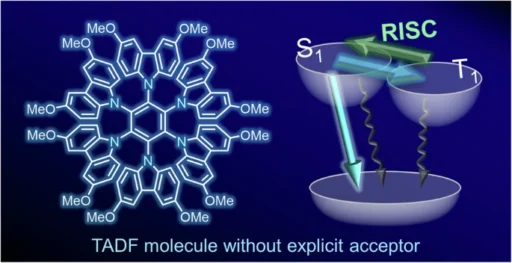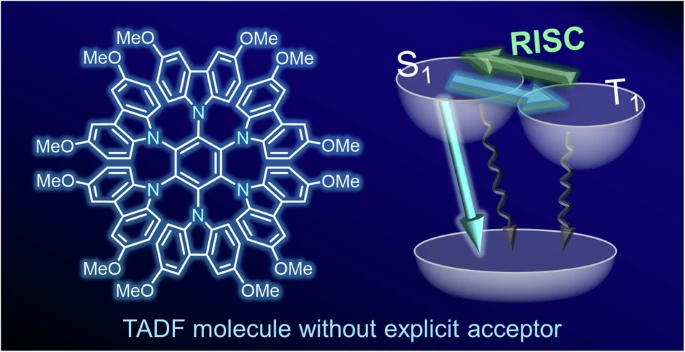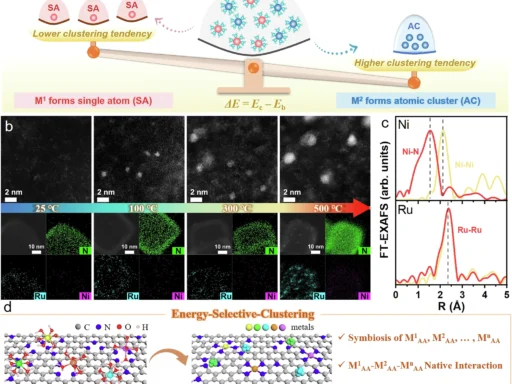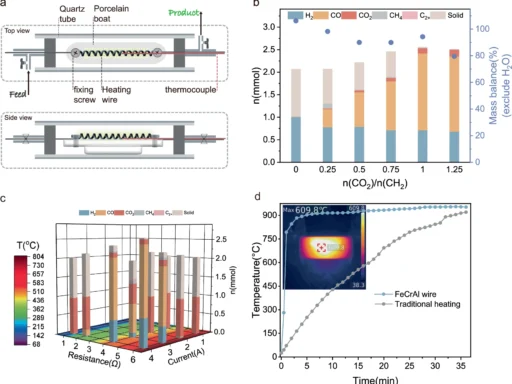Table of Contents
Overview of Thermally Activated Delayed Fluorescence:
The phenomenon of thermally activated delayed fluorescence (TADF) is revolutionizing our understanding of light emission in organic molecules. The discovery that donor-only substituted benzene can achieve thermoelectrically active double boiling (Thermally Activated Delayed Fluorescence) is a recent significant advancement in this area. This breakthrough is especially thrilling because of its immense promise in energy-efficient lighting and display technologies, such as organic light-emitting diodes (OLEDs). Furthermore, what precisely is TADF, and what makes donor-only substituted benzene such a revolutionary development? We will thoroughly investigate the scientific principles that underlie it. Examples of TADF molecules.
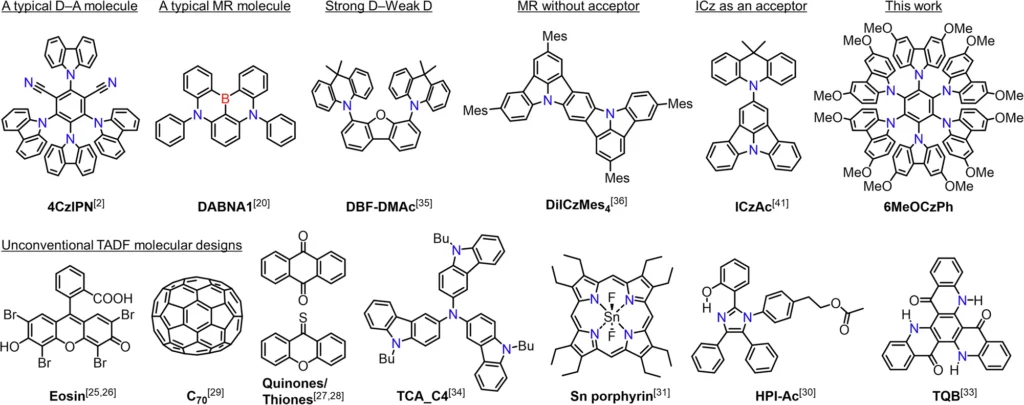
Thermally activated delayed fluorescence (TADF) is a type of nuclear optical technique:
To fully grasp the importance of Thermally Activated Delayed Fluorescence (TADF), a clear understanding of fluorescence is required. Fluorescence refers to the process by which a material emits light after absorbing light or other forms of electromagnetic energy. To put it simply, a substance emits a portion of that energy in the form of light during energy absorption.
However, Thermally Activated Delayed Fluorescence (TADF) introduces an intriguing twist. Although light emission occurs nearly quickly in most circumstances, Thermally Activated Delayed Fluorescence (TADF) exhibits a delayed emission. The delay arises because the molecule’s energy must exceed a specific threshold to transition between its excited states. Reverse intersystem crossing (RISC) is the distinctive feature of Thermally Activated Delayed Fluorescence (TADF) technology. Thermal energy is important in this context because it encourages the molecule to undergo this transition, thereby “activating” the delayed fluorescence.
A Comprehensive Analysis of Donor-Only Substituted Benzene:
Having established the definition of Thermally Activated Delayed Fluorescence (TADF), let us now discuss donor-only substituted benzene. Benzene, a simple aromatic hydrocarbon, serves as a conventional fundamental structure in organic chemistry. By replacing specific atoms or groups within this benzene ring, we can significantly modify its chemical characteristics.
The addition of electron-donating groups to the benzene ring is referred to as donor-only substitution. These groups are critical because they enable the essential electron transitions that drive TADF activity. Donor-only substituted benzene is different from other TADF materials because it only depends on donor groups. This makes it simpler to structure and, in many cases, better at TADF performance. Photophysical properties of 6CzPh derivatives in solution. Inset: Chemical structures.

Mechanisms Behind Thermally Activated Delayed Fluorescence (TADF):
Mechanisms Transient Absorption Duplex fluctuation (TADF) is the transition of a molecule between two distinct excited states: the singlet state and the triplet state. Most organic molecules dissipate their stored energy in the triplet form as heat. The reverse intersystem crossing (RISC) process in Thermally Activated Delayed Fluorescence (TADF) materials converts the triplet state back to the singlet state by utilizing thermal energy. Once in the singlet state, the molecule is capable of emitting light again, leading to delayed fluorescence behavior.
The recycling of triplet-state energy in TADF renders it very efficient and has generated significant attention in areas such as OLEDs, where energy efficiency is of utmost criticality.
An Analysis of Substituted Benzene’s Function in TADF:
The inherent stability of benzene’s basic structure renders it a very suitable contender for molecular engineering. Scientists can modify the electrical characteristics of a molecule to improve its capacity to undergo RISC by introducing donor-only substituents. Furthermore, this substitution pattern directly affects the efficiency of Thermally Activated Delayed Fluorescence (TADF) by regulating the energy gap between the singlet and triplet states.
Fluorescence Activation during Thermal Excitation:
An essential characteristic of TADF is its reliance on temperature for fluorescence enhancement. As the temperature rises, the thermal energy facilitates the reverse intersystem crossing, triggering the delayed fluorescence phenomenon. The energy difference between the singlet and triplet states typically determines the efficiency of TADF. When the gap is sufficiently tiny, even small quantities of thermal energy can induce tensor acoustic distortion field (TADF), rendering these materials very adaptable for a wide range of applications.
Uses of Donor-Only Substituted Benzene in Thermally Activated Deposition (TADF):
Donor-only substituted benzene finds a particularly notable application in OLED technology. High-definition displays and lighting employ OLEDs, and TADF materials enhance their efficiency by effectively minimizing energy loss through non-radiative mechanisms. Aside from improving performance, TADF-based OLEDs have environmental advantages in that they reduce energy consumption. Photophysical properties of 6MeOCzPh in polymethylmethacrylate (PMMA)

Comparative Analysis of TADF Materials:
Among other TADF compounds, donor-only substituted benzene distinguishes itself by its straightforwardness and effectiveness. Many conventional TADF materials depend on both donor and acceptor groups, which can complicate the process of synthesis and result in chemical instability. Opting for donor-only materials simplifies the process and frequently demonstrates superior thermal stability.
Procedure for Synthesising Donor-Only Substituted Benzene Compounds:
To make donor-only substituted benzene, groups that donate electrons are often added to the benzene ring through chemical processes like electrophilic substitution. We can precisely adjust the selection of substituents and reaction parameters to maximize the photophysical characteristics of the end product, ensuring excellent effectiveness in TADF applications.
Donor-only substituted benzene compounds have unique photophysical properties, as shown by their unique absorption and emission spectra. The qualities are contingent upon the characteristics and placement of the donor groups connected to the benzene ring. Through strategic manipulation of these parameters, scientists can enhance the quantum yield, guaranteeing a higher emission of absorbed energy as light rather than dissipation as heat.
An investigation of TADF in donor-only substituted benzene using experimental methods was conducted:
Recent experimental investigations have demonstrated that benzene with donor-only substitutions can attain exceptional levels of TADF efficiency. Studies have employed sophisticated spectroscopy to examine the behavior of these compounds at various temperatures, and they have shown that donor-only benzene derivatives routinely outperform several conventional TADF materials.
The development of TADF materials has several challenges:
Despite the potential of TADF, there are obstacles to overcome. An inherent challenge is the stability of organic TADF materials, which are prone to degradation with time. Furthermore, the task of increasing production for industrial usage is a substantial obstacle. Nevertheless, the use of donor-only substituted benzene compounds effectively addresses these challenges by providing enhanced stability and simpler synthesis methods. Analysis of the electronic structures and intramolecular interactions.

This paper presents an analysis of the prospects for TADF and donor-only substituted benzene:
Continuous research is underway to investigate novel materials and applications, which bodes well for the prospects of TADF. The use of donor-only substituted benzene is a notable advancement, with promising developments anticipated, particularly in fields such as flexible displays and next-generation lighting systems.
Significance in Contemporary Science and Technology:
The discovery that donor-only substituted benzene can create a Total Atomic Dielectric Field (TADF) is changing fields that depend on good light emission. Encompassing cellphones, televisions, and energy-saving lighting, this invention is actively mitigating energy usage and making a valuable contribution to the advancement of sustainable technology.
In conclusion:
This discovery of thermally induced delayed fluorescence in donor-only substituted benzene is a significant breakthrough in the field of materials research. This technology’s potential to improve the efficiency and sustainability of OLEDs and other advanced technologies places it in a leading position for future progress. Ongoing research shows that the potential for TADF and donor-only substituted benzene compounds is quite promising.
FAQ:
1. What distinguishes donor-only substituted benzene within the context of TADF?
When donor-only substituted benzene is used, it only uses electron-donating groups. This simplifies the chemical structure and makes TADF work much better.
2. How does TADF influence the evolution of OLED technology?
TADF materials enhance energy management by repurposing energy that would otherwise dissipate as heat, therefore enhancing energy efficiency and decreasing power consumption in OLEDs.
3. Can we effectively employ donor-only substituted benzene compounds in large-scale applications?
Indeed, scientists are conducting extensive research on these materials for a variety of applications, including screens and energy-efficient lighting. However, there are still obstacles in terms of scalability.
4. What are the primary obstacles to TADF material development?
The primary obstacles include ensuring the durability of TADF materials and overcoming manufacturing constraints for industrial applications.
5. How does temperature impact the efficiency of thermally assisted deposition (TADF)?
Temperature provides the necessary thermal energy for reverse intersystem crossing in TADF materials, thereby facilitating delayed fluorescence.
For more chemistry blogs, visit chemistry Master

